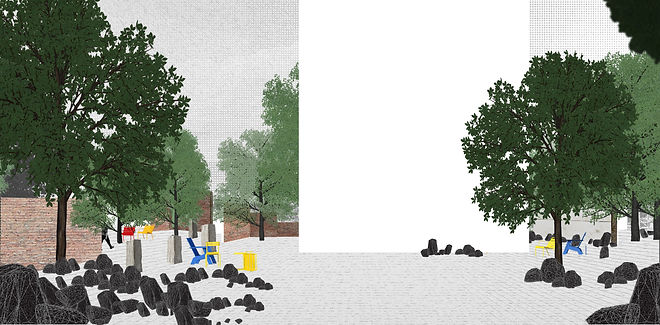Plotting New Outline for the Future
Honorable mention
International open ideas competition for 2017 UIA Seoul
Seoul, Korea
2017
With Kangil Ji, Namjoo Kim


As a strategy to restore original form and (ecological) function of fragmented ridge on the site, we propose to use existing structures to thicken and re-connect the disintegrated line by accumulating human and non-human elements through time: 1) sediment occur from natural erosion and weathering (silt, sand, gravel, rock crust, etc), 2) bodily waste of animals and pollen from plants, and 3) fragments of buildings and traces of temporal human activities (orchard tree, nursery, temporary structures, etc). Those elements will be accumulated between existing structures, and will thicken the ridge line through time with mixture of human and non-human activities and associated memories.
After a long period of time, accumulated elements (future presences), together with current and past presences (existing buildings and geological layers buried underneath) on the site will become a scale and marker representing history of human age. Explorers who visit the site would encounter various flora and fauna and remnants of human activities collected in diverse pitches between walls. Accumulated elements would form a thick layer, and become a geological marker representing human age.
At the dusk of their age (Anthropocene), humans start plotting a new outline of city for the future age (Post-Human), not only to create more biosynthetic urban framework, but also to transmit their memory to posterity.
Seoul, different from conventional idea of city - 'concentric zone model' on planar land, can be better understood by reading its verticality: series of mountains forming its overall structure (valleys and ridges) and vertically-distributed ecosystem. In addition, mountains in Seoul has been storing geological elements for millions of years (rocks and strata) and became a habitat for numerous species. Yet, in modern urban planning, this topographical aspect has been widely neglected. And mountains and its ridges has stood the same, regardless of rapid change on the city’s layout. Ironically, this unchanged part of the city -mountain and ridges- reserves possibilities of restructuring the city and re-connecting humans with immense layers of time and species.
Given this, the proposal focuses on reading the site’s (Sowol-ro 20-gil) character as a ridge space, and find its role and possibilities in forming new outline of the city’s biosynthetic future. It proposes restoring original form of the site (as ridge space) by accumulating human and non-human elements on it. The process would occur in long time period, and would proceed not by artificial intervention, but through the circulation of nature.

Repetition of the accumulation process would slowly transform the site from a mundane urban space to part of the mountain through the process of natural succession, and it creates 'Gallery of Time and Presences', which stores diverse human and non-human elements aligned on a line between walls with diverse intervals.
While walking along the site, Post-Humans would perceive a sense of 'Compression of time and space', by looking at overlayed elements from different time period: outline of ridges on far-away mountains from Prehistoric Age, remaining structures from Human Age, and biospecies from Human and Post-Human Age. Eventually, this space enables them to recognize overall structure of the city and its ecosystem, and to get balanced awareness on the process of ecological succession .





In the far-future, the strategy of restoring ridges to its original form is spread throughout the whole city, and creates a new outline on the city’s image and operation. By this time, Seoul will have dual framework operating in different levels: road system on lower areas (built in Human Age) and connected ridge space at higher level (to-be completed in Post-Human Age).
This dual-framework enables Post-Humans to live in the environment with different urbanity from the Human-age. Connected ridge lines exist neither as nature nor part of city. It operates as an intermediate space where 1) artifacts and memories of Human age is stored and still affecting Post-Human urbanity (Space and Marker), 2) frequent interaction between human and non-human entities occurs, while allowing them to interact with their past and to observe process of ecological succession (Gallery of Time and Presences), and 3) Post-Humans envision a balanced future of their species by constantly looking back remnants from their past.
